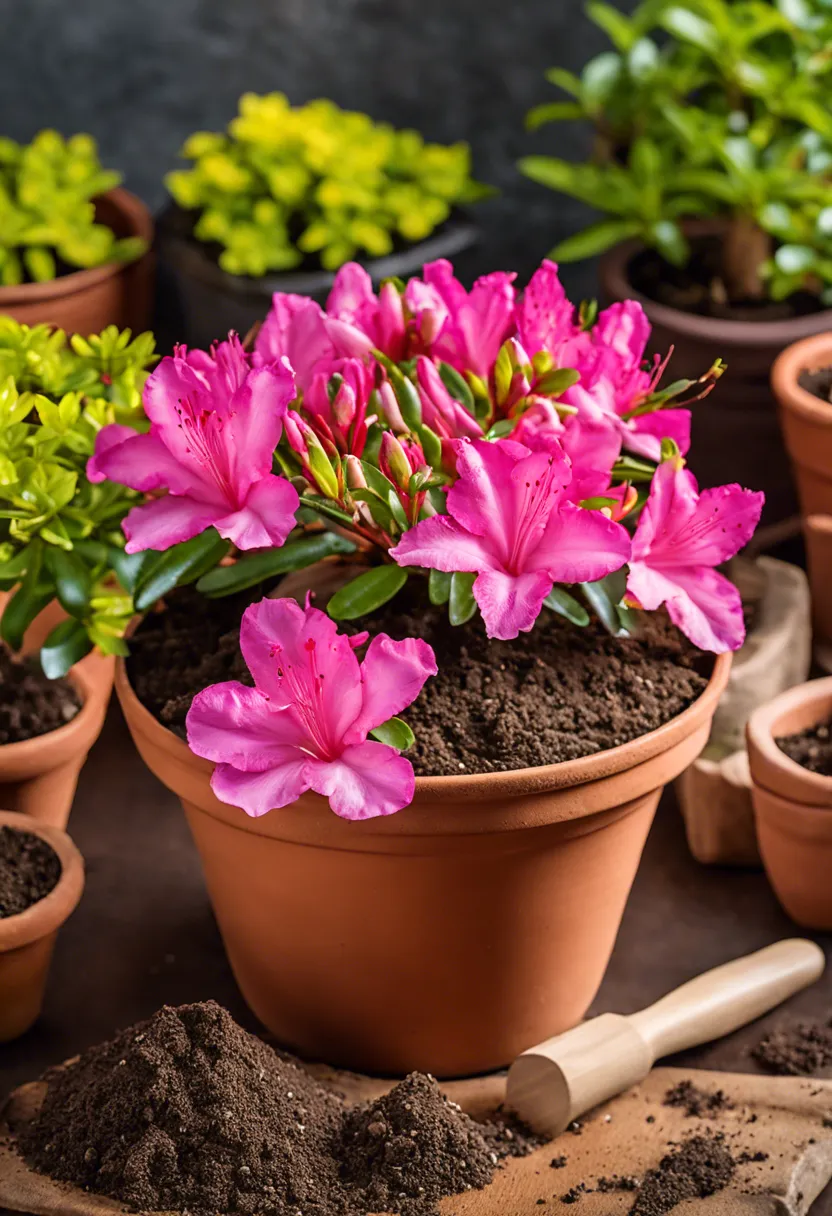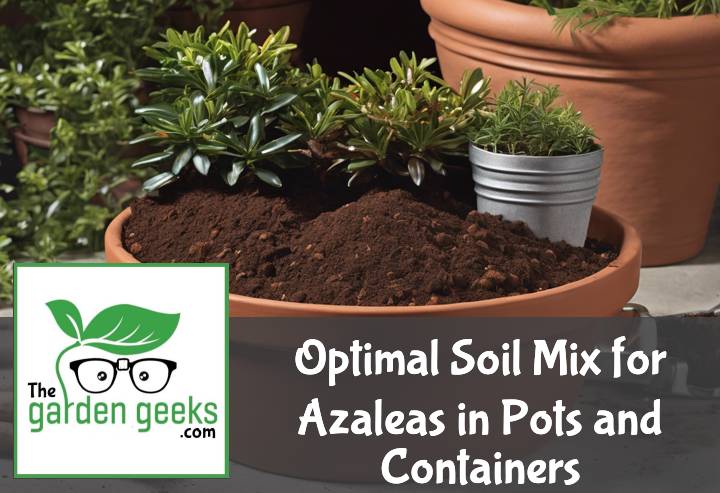Did you know that azaleas, with their vibrant blossoms and lush foliage, are among the top three potted plants sold worldwide? These beauties owe their success to more than just good looks. The secret lies in the Optimal Soil Mix for Azaleas.
Azaleas require a specific soil mix to thrive. This mix not only provides necessary nutrients but also ensures proper drainage and maintains an ideal pH level. Understanding this can make all the difference between a flourishing azalea plant and a wilting one.
So if you’re looking to give your azaleas the best possible care, it’s time to delve into the world of optimal soil mixes. Keep reading about Optimal Soil Mix for Azaleas!
Quick Answer
- Optimal Soil Mix for Azaleas should be well-draining, rich in organic matter, and slightly acidic (pH 4.5-6.0).
- Key components include organic material like compost or peat moss, drainage materials such as perlite or sand, and pH adjusters like sulfur or iron sulfate.
- To create your own mix, combine these elements in the right proportions: 60% organic material, 30% drainage material, and adjust pH as needed.
- Maintain soil quality by regularly checking pH levels and refreshing nutrients when necessary.

What Makes an Optimal Soil Mix for Azaleas in Pots and Containers?
Importance of Soil Composition for Azaleas
Getting the soil composition right for your azaleas is like making a perfect bed for them to sleep in. It’s super important because the right mix can make or break how well they grow. Imagine trying to sleep on a bed that’s too hard or too soft; it’s the same deal with plants and their soil.
Different components in the soil, like peat moss, sand, and perlite, work together to create a cozy environment. They help control moisture so the roots don’t get too wet or too dry. This balance is crucial because azalea roots are pretty picky and hate being waterlogged.
The right soil composition also makes sure your azaleas get all the yummy nutrients they need without overdoing it. It’s like feeding them just the right amount of their favorite food. Plus, good soil helps protect against diseases that can sneak up on unhealthy plants.
In short, think of soil as a personal chef and bodyguard for your azaleas. The better the soil composition, the happier and healthier your plants will be.
Characteristics of Ideal Soil Mix for Azaleas
An ideal soil mix for azaleas is kind of like a secret recipe that keeps them happy. First off, it needs to be well-draining because azalea roots despise sitting in water. Imagine wearing wet socks all day; that’s how uncomfortable it is for them!
Next up, this magical mix should be slightly acidic. Azaleas love acid – not the scary kind but the type that makes their nutrients more accessible. It’s like adding just the right spices to make a dish pop.
Also, an ideal soil mix includes organic matter – think compost or aged bark. This stuff is gold for azaleas because it adds nutrients slowly and improves soil structure, making roots strong and happy.
Lastly, airiness is key! Roots need to breathe too, so adding materials like perlite helps keep things light and airy. Think of it as fluffing up a pillow before you lay down – roots appreciate that kind of comfort too.
So there you have it: drainage, acidity, organic matter, and airiness are what make an ideal soil mix for azaleas not just good but great!
Components of the Best Soil Mix for Azaleas
Creating the perfect azalea soil mix involves blending organic material, drainage materials, and pH adjusters. Each plays a vital role in nurturing robust azalea plants.
Organic Material: Types and Benefits
Organic material is like a superfood for azaleas. It helps the soil hold onto nutrients and water, which are essential for plant health. One great option is compost. Compost adds valuable nutrients back into the soil, making it a powerhouse for azalea growth. Another fantastic choice is peat moss. Peat moss improves soil structure and moisture retention, which are critical in potted environments. Then there’s leaf mold, a decomposed leaf matter that enriches the soil with minerals and improves its texture. Each type of organic material has its unique benefits, but they all contribute to creating an ideal environment for azaleas to thrive.
Drainage Materials: Ensuring Proper Water Flow
Azaleas hate having wet feet! That’s why ensuring good water flow in their pots is crucial. Let’s talk about perlite first. Perlite is a volcanic glass that improves soil aeration and drainage – think of it as making the soil more breathable for roots. Then there’s sand, which helps by adding roughness to the mix, allowing water to flow more freely between particles. Lastly, pine bark fines can be mixed into your azalea potting mix to not only aid in drainage but also add slight acidity to the soil, which azaleas love.
pH Adjusters: Achieving the Right Acidity Level
Azaleas are picky about their pH levels; they thrive in slightly acidic soils. This is where pH adjusters come into play. Sulfur is a go-to choice for lowering pH levels gently over time, making it perfect for getting just the right acidity azaleas crave. On the flip side, if your soil is too acidic, garden lime can help raise the pH level to suit your plants better. Understanding how these adjusters work and their impact on your azalea‘s growth will ensure you’re providing the best possible environment for your vibrant blooms.



How to Create Your Own Azalea Potting Mix


Creating the perfect potting mix for your azaleas isn’t just about throwing some soil in a pot and calling it a day. It’s about mixing the right ingredients to give your plants the best possible home. Let’s break down how you can make your own azalea potting mix, step by easy step. Remember, azaleas love slightly acidic soil and good drainage!
-
Gather your materials. You’ll need sphagnum peat moss, perlite, and pine bark fines. These are the secret ingredients to making an azalea-friendly environment. Don’t forget a big container to mix it all in!
-
Measure out two parts of sphagnum peat moss. This stuff is like magic for azaleas because it helps keep the soil acidic and retains moisture without getting soggy.
-
Add one part perlite to the mix. Perlite is those little white bits you see in potting mixes; they’re not just there for looks! Perlite improves drainage and makes sure your azaleas’ roots aren’t sitting in water.
-
Throw in one part pine bark fines. Pine bark not only continues the theme of acidity but also adds texture to your mix, helping with airflow around those delicate roots.
-
Get your hands dirty! Mix everything together thoroughly in your container. You want each component evenly distributed so every root gets its share of the good stuff.
-
Test the pH if you can. Azaleas thrive in soil that’s slightly acidic, ideally between 4.5 and 6.0 pH level. If it’s too high or too low, consider adding sulfur (to lower pH) or lime (to raise pH) accordingly.
-
Now that your mix is ready, it’s time to pot up your azalea! Fill a pot with enough mix so when you place your plant inside, the top of its root ball is about an inch below the rim of the pot.
-
Water well after planting, ensuring any excess can drain freely from the bottom of the pot – remember, good drainage is key!
By following these steps, you’ve created a cozy, nutrient-rich home for your azalea that will support its growth and flowering potential beautifully.
Maintaining Soil Quality Over Time
Keeping your azaleas happy in pots means keeping an eye on the soil quality. It’s like making sure your pet has fresh water every day. You wouldn’t forget about them, right? So, don’t forget about checking pH levels and giving the soil a nutrient boost when needed.
Monitoring and Adjusting pH Levels
Azaleas love their soil just right – not too sour, not too sweet. Think of it as making the perfect lemonade. To keep it perfect, you’ll need to do some soil pH testing every now and then. If the soil is too grumpy (alkaline), you’ll have to add something to make it smile (more acidic). That’s where acidic soil enhancement comes into play.
But how do you know if you need to adjust? Grab a soil pH testing kit from your local garden store. It’s like a mood ring for your soil. If the test shows that your soil is throwing a tantrum (too alkaline), mix in some sulfur to calm it down. On the flip side, if it’s too mellow (too acidic), a bit of lime will pep it up.
Remember, azaleas are picky eaters. They won’t thrive unless the pH is just right. Aim for a pH that makes them feel at home, which is slightly acidic.
Refreshing Soil Nutrients Periodically
Plants are like us; they get hungry and need different types of food to grow strong and healthy. For azaleas, this means getting a steady diet of nutrients through soil nutrient replenishment. Think of it as refilling their plate at the buffet.
Every so often, give your azaleas a treat with some organic compost or a sprinkle of slow-release fertilizers designed for them. This is like giving them their favorite snack but in plant form.
Using organic compost for azaleas can be like cooking a gourmet meal for them—it’s packed with all sorts of goodies they love! And those slow-release fertilizers? They’re like time-released capsules of joy ensuring your azaleas get steady nutrients without overfeeding.
Don’t forget; this isn’t just a one-time deal. Keep checking on your plant babies and feed them regularly to keep those blooms coming back year after year.


To Wrap Up
So, you’ve learned all about the Optimal Soil Mix for Azaleas. Remember, azaleas love a blend of organic matter, sand, and garden soil. They need a pH between 4.5 to 6.0.
Don’t forget to check drainage! Azaleas hate waterlogged roots. If the water doesn’t drain well, add more sand.
Finally, show your azaleas some love! Feed them with a slow-release fertilizer made for acid-loving plants. Happy gardening!
Question
What are azaleas and why do they require a specific soil mix?
Answer
Azaleas are flowering shrubs that thrive in acidic soil with good drainage. They need a specific soil mix to support their root growth, maintain the right pH level, and provide necessary nutrients.
Question
Can I use garden soil for potting Azaleas?
Answer
It’s not recommended. Garden soil may not have the right pH balance and it often lacks the drainage qualities needed by Azaleas. Specialized potting mixes are better for these plants.
Question
Is there a difference between soil for potted Azaleas and those planted directly in the ground?
Answer
Yes, potted Azaleas need soil that retains moisture but also drains well to prevent root rot. Ground-planted Azaleas can tolerate slightly denser soils.
Question
How often should I refresh or change the potting mix for my Azalea?
Answer
Typically, refreshing or changing the potting mix every 2-3 years is beneficial as it replenishes depleted nutrients and maintains optimal growing conditions.
Question
Why is pH level important in an Azalea’s soil mix?
Answer
Azaleas prefer acidic soils with a pH of 4.5-6.0. If the pH is off, it can affect nutrient absorption leading to poor growth and less vibrant blooms.
Question
Can I use homemade compost as organic material in my Azalea’s potting mix?
Answer
Absolutely! Homemade compost is rich in nutrients and helps improve water retention while maintaining good drainage – perfect for your Azalea’s needs.


